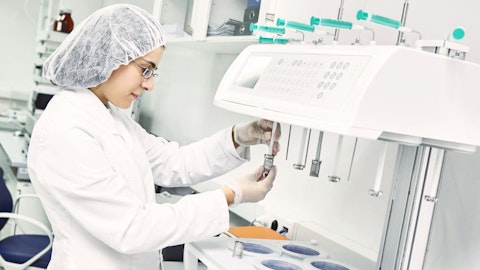Operator: Our next question comes from John Sourbeer of UBS. Please go ahead, John.
John Sourbeer: Just with the increase in the COVID guidance in that greater than $600 million in strength in 4Q, any one you could provide some color on what the endemic COVID runway looks here even beyond fiscal ’23? And what should we — how should we think about this long term?
Tom Castellano: Well, I think it’s a difficult question to answer, John. So, we’re going to hold back from giving any more specifics around what fiscal ’24 could look like here. But I think the relationship and the continued relationship and strategic partnership that’s been extended as well as expanded with Moderna, I think, speaks to the future that we believe exists for COVID- and vaccine-related revenue in the future for us. But again, we’re going to fall short of giving any specific run rate as we exit this year in terms of what that could look like for us in ’24.
Alessandro Maselli: I’m going to add one comment to this one. Look, the fact that we are bringing online more assets into the network surely will contribute to the ability of running an endemic business with better productivity and profitability.
John Sourbeer: If I could ask sneaking a follow-up, the Company has previously said, I think, working on greater than 150 supported gene therapy products. Any update just on the number of programs here? And just how we think about with the additional capacity coming online in that non-Sarepta opportunity with some of these programs?
Tom Castellano: Yes. I wouldn’t say there’s any change to that. We continue to work on about 150 development programs across that part of the business. That’s what has justified further capacity expansions within that space. And I would say not only we’re pleased with the number of programs we work on, on the gene therapy side of the business but also the progression and maturity of those that continue to move from earlier phase to a later phase. And obviously, the Sarepta relationship and program or programs is just one example of that. So again, feel very good about the growth prospects and opportunities in this business.
Operator: Our next question comes from Evan Stover with Baird. Please go ahead, Evan.
Evan Stover: Just one for me because as John asked one of mine, but this is a cleanup. Last quarter, you said you had some efficiency initiatives that were in flight and in your last updated guidance, so I just wanted to be perfectly clear that 75 to 85 of efficiency actions that you kind of noted today. Is that, that prior program or is that incremental addition — an additional cost savings to your guide today?
Tom Castellano: No. Evan, these were all originally contemplated. We felt the need to be able to provide some additional disclosure and meat on the bone, if you will, related to the cost savings initiatives. The 700 headcounts we’ve talked about were difficult for us to talk through at the time of our last guidance because we weren’t able — we didn’t execute on those, but now we’ve since executed on that through the end of the calendar year, so we’ll see half of that run rate savings in the current fiscal year with the remaining half to be carried into the first half. So, you should look at that annualized number across calendar ’23 versus our fiscal year. And I would say the further commentary around the tens of millions of dollars related to other cost savings initiatives, efficiencies and procurement programs were also contemplated as part of the original guide.
Operator: Our final question comes from Jack Meehan of Nephron Research. Please go ahead, Jack.
Jack Meehan: So, I want to talk about core organic growth. It was over 20% last quarter, it was 4% this quarter. Can you frame for us the math on some of the moving parts that led to the quarterly slowdown? And then for 3Q, is the reacceleration over 20% happening right now? Just talk about your visibility at the end of that.
Tom Castellano: Sure. So Jack, I think we’ve said in Alessandro’s comments that one of the things we needed to do was prioritize a COVID-related program related to the emergency use authorization of the pediatric COVID vaccine over non-COVID-related revenue out of our Bloomington facility. I’m not going to be in a position to tell you what our non-COVID growth would have been in the second quarter. If we weren’t prioritizing that program, but that certainly had a significant impact and why we were only able to achieve 4% non-COVID growth in Q2 and 12% non-COVID growth in Q2 for the Biologics business. But it’s not necessarily the same assets and lines that are being utilized, but it’s certainly the same operations and quality folks that we have in terms of putting in the time and efforts around releasing of batches.
So, that certainly played into why we had a depressed non-COVID-related growth in the second quarter. So, I think returning in the third quarter back to non-COVID levels that we have seen through the first quarter of the year is what I would consider to be normal course or a low bar based on what we’ve been able to show. And again, the uptick in COVID-related revenue that we expect to see in the fourth quarter is really offsetting the pullback on the PCH side of the business, where we continue to experience headwinds, particularly in consumer health.





